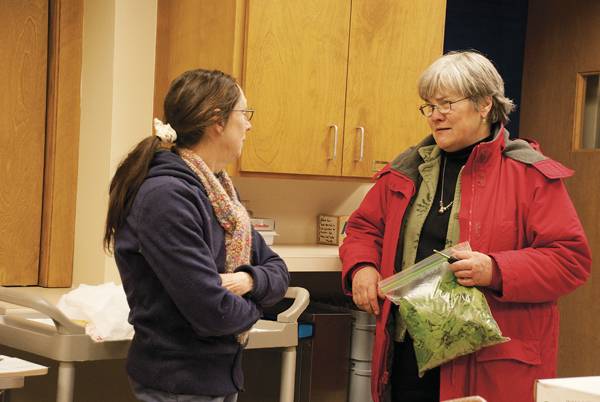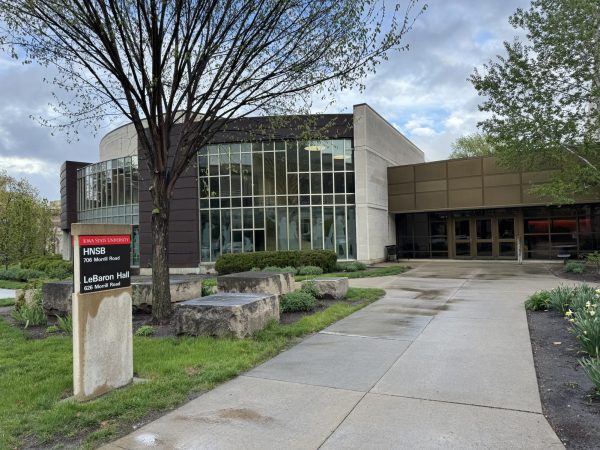CSA programs connect farmers with Ames consumers

Marilyn Andersen, coordinator of Farm to Folk, talks with Paula Weidner, of Ames, after distributing vegetables that Weidner bought through the program at First Christian Church, the drop-off site. Photo: Karuna Ang/Iowa State Daily
March 22, 2010
Marilyn Andersen knows where her strawberries come from. She didn’t buy them in a grocery store, and they weren’t specially ordered from a berry patch in California.
Andersen gets her shipment of strawberries from Berry Patch Farm in Nevada through the Farm to Folk Community Supported Agriculture — CSA — program in Ames.
Farm to Folk began as Magic Beanstalk CSA in 1995. Its name was changed in 2007, said Andersen, coordinator of the program.
Farm to Folk is open year-round and provides consumers with different share options in a variety of price ranges.
“With a CSA share, a person would pay at the beginning of the season, and then each week during the growing season they would get a delivery of fresh produce of whatever is ripe and ready for that week,” Andersen said.
The “a la carte” option allows CSA members to choose as often as they want from a list of available items, updated each week.
“If you don’t want to have a CSA share, where you’re committed to paying at the beginning and getting something every week, with the ‘a la carte’ you can order on an as-needed basis,” Andersen said.
Helen Gunderson, of Ames, uses the “a la carte” ordering option to order chickens and honey from Audubon County Farm, and corn kernels, pancake mix and wheat berries from Paul’s Grains.
“I very much believe in the use of locally grown foods, and the grocery stores in Ames don’t really carry a lot of that,” Gunderson said.
While the push to get to know the producers is good, Gunderson said she’s met more of them through the farmers market since some of the producers don’t stick around during the Tuesday delivery date to talk to customers.
“If you’re expecting to get to know your farmer and have a social experience, sometimes I find more of that by going to the farmers market in the summer,” she said.
Nick Wallace, a beef and lamb producer from Keystone, said he’s been able to connect with his customers and other producers through the CSA.
Wallace coordinates the distribution of several meat products through 10 different CSA programs, including four in Chicago.
Besides his beef and lamb products, Wallace processes Berkshire pork, fish from Alaska, shrimp from Florida, dairy from Minnesota, turkeys from Minnesota and chickens from Kalona, Iowa.
“It’s a nice way to collectively organize your customers,” he said. “The nice thing about Farm to Folk is it works well on both sides. As producers you can have all your customers all in one spot and organized. But on the other side, it’s nice for consumers because all the producers are in one spot.”
He said it’s “less money and more work” selling to grocery stores than to consumers.
He said government regulations and the competition for business are two of the toughest components when supplying for grocery stores and markets.
Andersen said there is a cost difference between products ordered from the CSA and those purchased in a grocery store.
“We find that it is a little bit less expensive than if you buy any of the organic products at any of the grocery stores,” she said.
“It’s a little bit more than conventional produce at the grocery store, but it’s less than the organic.”
Between all the CSA programs Wallace supplies, he connects with 500 consumers per month.
“I think the common thread is everyone wants to know where their food’s coming from,” he said. “They like to know who raised it and how they raised it.”
Sumana Srinath, of Ames, has been a Farm to Folk CSA member for three years.
She said she prefers going to the CSA for her milk and vegetables.
“I know it’s all locally grown,” she said. “It’s the freshest produce you can probably get.”
She said she prefers the milk through the CSA because it’s organic, and the vegetables because they are fresh.
“I’m more into local grown than organic because it’s much fresher; the taste is much better,” Srinath said.
She said she uses the “a la carte” ordering option, and in the summer she orders a share of fruits and vegetables.
Andersen said 15 to 20 people pick up orders every week this winter.
Farm to Folk had 184 members last year. The CSA sold 100 fruit shares and 90 vegetable shares.
“I think it’s a really great way to get fresh produce all year round,” she said.
“You do know where the food came from; it’s local. The quality might be a little better quality than in the grocery store, just because it’s fresh — it’s been picked that day.”
















